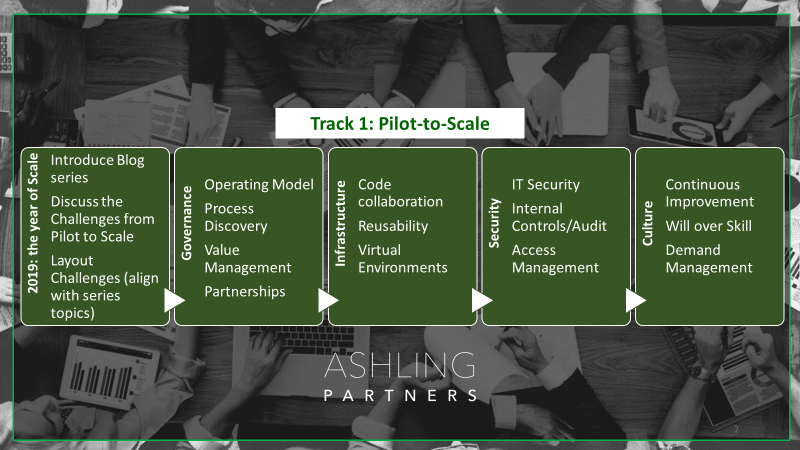Introduction
Business wide transformation and the future of work are hot topics across all industries today. Unfortunately, many organizations that begin their automation journey are ill prepared for the steps required to scale their pilot effort into an enterprise-grade automation program. This article is the first part of an ongoing Ashling Partners’ blog series where we discuss the journey towards scale of both RPA technologies and an intelligent automation capability. The first part will define a pilot vs enterprise-grade automation and provide an introduction of the considerations and success factors in going from pilot to scale. The remainder of the series can be viewed via our newsletter or blog.
Pilot vs. Enterprise Grade
In order to test RPA functionality, determine if it works within their IT environment, and meet the requirements for a business process that is an ideal automation candidate, organizations many times will automate a pilot process. Even before a Pilot is conducted, many organizations will begin with a Proof of Concept (“POC”) directly with a RPA vendor, and it is very important to understand the difference between a POC and a Pilot. For the purposes of this article, we will begin our journey with the Pilot.
The pilot facilitates the performance of key tasks within a workflow business process that includes all steps in the process but does not include the full scope needed for end-to-end automation like exception handling. Most importantly, a pilot process is production grade, whereas a POC is not. A pilot process can and should be leveraged by an organization to lay the framework for an enterprise grade automation and provide a strategic framework for the way forward.
An enterprise grade solution includes the full scope of a business process and addresses all exception handling. The solution includes reporting and dashboards provided by the RPA vendor and allows the organization to monitor the performance of the process, measure against KPIs, and automate the process in its entirety. The goal of an enterprise grade automation solution is to execute against pre-defined business outcomes, provide a platform that can be iteratively enhanced, and capture process analytics that can be used to review, analyze, and improve business processes.
For example, if an organization chooses to automate their supplier invoice intake process, they can choose to first automate one type of invoice (those received via email) as a pilot. Exceptions in the process are handled via manual intervention by an employee in Accounts Payable in this scenario. Once the pilot is complete, the next step would be to automate the full supplier invoice process, which can include invoices received via EDI, by hand, etc. The bot handles supplier invoices for all departments.
Moving from Pilot to Enterprise
The pilot process represents an inflection point for an organization to consider where they stand on multiple factors listed below. Additionally, it provides an opportunity to address and improve the organization in ways that align with the desired business outcomes of the automation initiative. Please see the next entry in our blog series as we tackle each of the factors that help drive enterprise- grade automation in more detail: Governance, Infrastructure, Security, and Culture.
Partnerships, Intelligent Process Automation, Future of Work, Robotic Process Automation (RPA), Artificial Intelligence (AI), Continuous Process Improvement, Business Process Outcomes (BPO)





